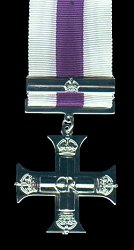Military Cross
The Military Cross ( German military cross ) is a military award of the United Kingdom , which is given to members of the British Army for excellent and meritorious service in combat. It used to be awarded to officers from other Commonwealth nations . It is the third most prestigious award for bravery of the British Armed Forces after the Victoria Cross and the Conspicuous Gallantry Cross . Since the Military Cross is only awarded to members of the Army, the Royal Navy (with the Distinguished Service Cross ) and Royal Air Force (with the Distinguished Flying Cross ) have their own decorations for bravery.
The Military Cross was donated by King George V on December 28, 1914 and officially introduced with effect from January 1, 1915. It was originally awarded only to officers with the rank of captain or below and to warrant officers . From February 5, 1931, this award was also given to officers with the rank of major . Since 1993, the award has also been given to other ranks below those of Warrant Officers. As far as the replaced Military Cross , the Military Medal , the award has been set.
Recipients of the Military Cross are entitled to use the letters MC after their name , which indicate the award (so-called post-nominal ). If a soldier who already holds the Military Cross is awarded this award a second time, he will receive a silver clasp (so-called “bar”) on the ribbon. There is no limit to how many times someone can receive the MC.
During the First World War , around 37,000 people were awarded the Military Cross. Of these, 3,000 were given a silver clasp for earning the Military Cross a second time, 170 were given a second clasp for their third Military Cross acquisition, and four were awarded three clasps for four times.
During the Second World War , the Military Cross was awarded a total of approximately 11,000 times. The same soldier was awarded the Military Cross twice in 500 cases.
The Military Cross is a flat, symmetrical silver cross with a bar length of 4,445 cm (1.75 inches ). The image of an imperial crown (located on each arm Imperial Crown ). The initial of the ruling sovereign ( GV , GVI , EIIR ) is at the bar intersection . On the flat back, on the lower bar, there is an engraving with the year of the award. A ring is soldered to the tip, which is connected to the ring of the tape holder via another. The ribbon is 3.49 cm (1.375 inches) wide of watery white color with a purple stripe in the center 1.27 cm (0.5 inch) wide.
See also
Individual evidence
- ↑ a b London Gazette (Supplement). No. 29024, HMSO, London, December 29, 1914, pp. 7-9 ( PDF , English).
literature
- Paul Ohm Hieronymussen: Handbook of European orders in colors . Universitas Verlag, Berlin 1966.
